2025 Weekly Cyanobacteria Emails to Monitors
LCC Week 1 2025 Cyano. Monitoring Report
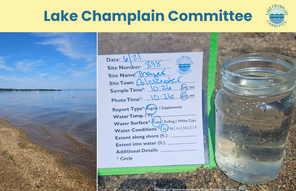
Thank you to everyone who submitted observations during the first week of the 2025 cyanobacteria monitoring season! Your reports are helping us build a clearer picture of lake and inland water conditions as the bloom season begins, and we’re so grateful for your continued commitment to this work.
LCC Week 2 2025 Cyano. Monitoring Report
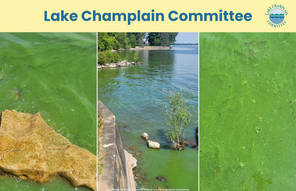
We hope you managed to stay cool during this stretch of extreme heat—thank you for continuing to monitor and report despite the temperatures! Please read through this email for details of Week 2 monitoring results along with resources to guide your reporting. Click on the links to celebrate three generations of monitors, meet monitors Laurie Sedlmayr and Alfred Cummings in our weekly Monitor Spotlight, observe some cloudy conditions, get a reminder on how to use the stick test, and take in some clear water clarity.
LCC Week 3 2025 Cyano. Monitoring Report
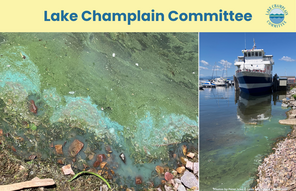
Thank you for your continued dedication to monitoring—your steady stream of bloom reports last week kept us busy. Each observation, photo, and jar sample helps us track where blooms are forming, how they're changing, and how we can better share data with the public and our partners.
LCC Week 4 2025 Cyano. Monitoring Report
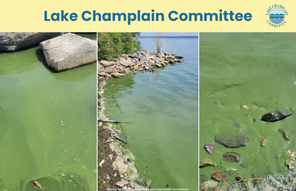
Blooms surged across several lake regions this week, especially on the New York side, and your reports were critical in keeping the public informed. We’re seeing more frequent and widespread cyanobacteria activity, and each report submitted helps us track and communicate these concerning conditions. Thank you for your continued diligence in helping safeguard public health and lake access.
LCC Week 5 2025 Cyano. Monitoring Report
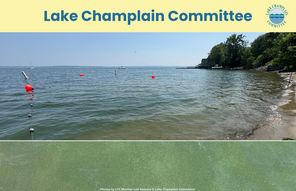
While bloom activity dipped slightly this week, cyanobacteria was still reported in several areas around the lake. Conditions remain variable, and your ongoing monitoring plays a critical role in identifying new blooms, tracking changes, and alerting the public to potential health risks. Thank you for helping protect both lake users and water quality.
LCC Week 6 2025 Cyano. Monitoring Report
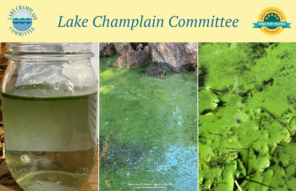
Cyanobacteria blooms persisted across the lake this week, with steady reports of Category 2 and 3 conditions from multiple regions. While some sites showed subtle discoloration or fine streaking, others experienced thick surface accumulations and dramatic color changes. As always, thank you for helping protect both lake users and water quality.
LCC Week 7 2025 Cyano. Monitoring Report
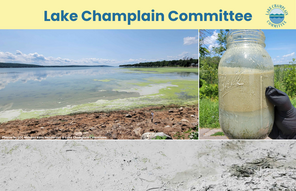
We saw an increase in blooms this week, with numerous reports coming from Missisquoi Bay and St. Albans Bay. Several sites also showed signs of blooms beginning to break down, with teal hues, wispy white streaks, and patchy surface accumulations. Thank you for continuing to submit reports and for your dedication to protecting Lake Champlain.
LCC Week 8 2025 Cyano. Monitoring Report
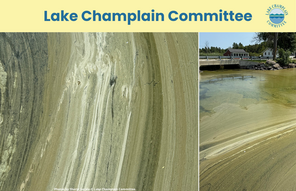
We saw blooms this week in the Inland Sea, Missisquoi Bay, Malletts Bay, and Main Lake North, along with reports from Lake Carmi and other inland lakes. Several sites also showed signs of blooms beginning to break down, with teal hues, wispy white streaks, and patchy surface accumulations. Thank you for your careful observations and for the time you dedicate each week to protecting our waters.
LCC Week 9 2025 Cyano. Monitoring Report
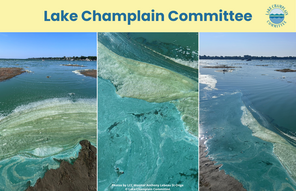
This week, we continued to see blooms in Missisquoi Bay and the Inland Sea, with additional reports scattered throughout the lake. While some areas remain clear, cyanobacteria is still present in several locations. With cooler weather on the horizon, it’s especially important to keep reporting your observations—whether you’re seeing blooms or clear water. Thank you for your commitment and the time you dedicate each week to keeping our waters safe and our communities informed.
LCC Week 10 2025 Cyano. Monitoring Report
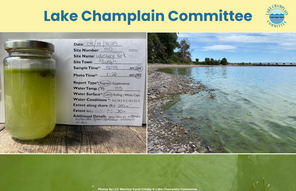
Blooms continued at high levels this week in both the Inland Sea and Missisquoi Bay, with additional isolated reports from other parts of the lake. While many sites remain clear, cyanobacteria is still active in several locations. As we move into September, your ongoing reports are especially valuable for tracking these late-season conditions. Thank you for the time, care, and dedication you bring each week to protecting Lake Champlain and informing our communities.
LCC Week 11 2025 Cyano. Monitoring Report
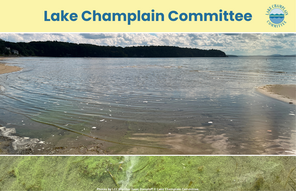
Fewer blooms were observed across Lake Champlain this week, likely due to cooler temperatures. The majority of blooms were classified as low alert, though some high alert conditions persisted in Missisquoi Bay. As we move further into the season, your ongoing reports remain invaluable for tracking these conditions. Thank you for the time, care, and dedication you bring each week to protecting Lake Champlain and keeping our communities informed.
LCC Week 12 2025 Cyano. Monitoring Report
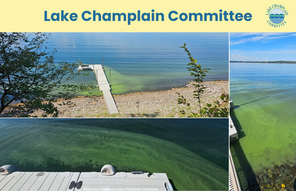
This week, cyanobacteria blooms were observed across the Inland Sea, Main Lake Central, and Missisquoi Bay. The highest concentration of blooms occurred early in the week, from 8/31 to 9/2, with many areas showing dense green mats and paint-like surface coverage. Your ongoing observations continue to be essential for tracking these blooms and keeping our communities informed. Thank you for your dedication and careful reporting each week.
LCC Week 13 2025 Cyano. Monitoring Report
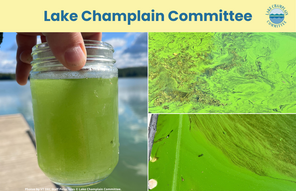
This week, cyanobacteria blooms were observed across Lake Champlain and several inland Vermont waterbodies. Overall, bloom activity was lower than last week, with a more even split between lower alert and high alert blooms. However, some inland lakes and portions of Main Lake Central experienced a higher number of blooms. Your continued observations remain essential for tracking these blooms and keeping our communities informed. Thank you for your dedication and careful reporting each week.
LCC Week 14 2025 Cyano. Monitoring Report
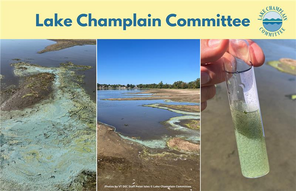
Although fall is officially here, cyanobacteria blooms were still observed across Lake Champlain and several inland Vermont waterbodies during Week 14. While the overall number of reports was lower, blooms occurred in several key areas on Lake Champlain, including the Inland Sea, Main Lake North, Main Lake South, Missisquoi Bay, and St. Albans Bay, as well as in Vermont waterbodies like Shelburne Pond and Lake Memphremagog. These Week 14 observations underscore the importance of continued monitoring well into the fall season. As always, please check water conditions carefully before recreating. Thank you for your ongoing dedication and careful reporting each week.
LCC Week 15 2025 Cyano. Monitoring Report
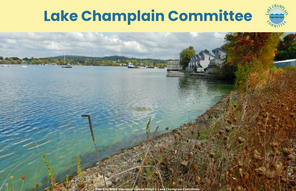
Even with cooler temperatures and autumn colors setting in, cyanobacteria blooms are still showing up across Lake Champlain and nearby Vermont waterbodies. During Week 15, the Main Lake South experienced a notably high amount of blooms, while Lake Memphremagog saw several high alert conditions. Other areas with reported blooms included the Inland Sea, Main Lake Central, Main Lake South, Main Lake North, and inland lakes such as Shelburne Pond. Blooms can persist well into the fall, so please continue to check water conditions carefully before recreating. Thank you for your ongoing dedication and detailed reporting each week.
LCC Week 16 2025 Cyano. Monitoring Report
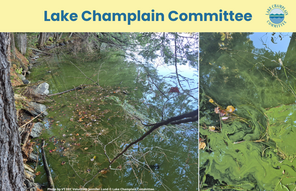
With fall now underway, cyanobacteria blooms are still being observed in multiple sections of Lake Champlain and in inland Vermont waterbodies. Even as the season progresses, blooms are persisting, so please continue to check water conditions carefully before recreating. Thank you for your ongoing dedication and detailed reporting each week.
LCC Week 17 2025 Cyano. Monitoring Report
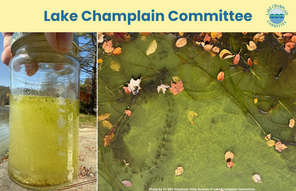
Even as fall advances and temperatures turn cool and crisp, cyanobacteria blooms continue to appear across Lake Champlain and Vermont’s inland waterbodies. This week, only low-alert blooms were observed in Lake Champlain, occurring in the Inland Sea and Main Lake North. Three inland Vermont lakes experienced blooms, with Halls Lake showing a high number of high-alert blooms. Please continue to check water conditions carefully before recreating, and thank you for your ongoing dedication and detailed reporting each week. We will share more information next week about the official end-of-season date.
LCC Week 18 2025 Cyano. Monitoring Report
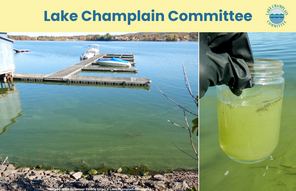
The 2025 monitoring season will officially end on November 8th. As we wrap up this year's program, we want to take a moment to thank you for your dedication and careful reporting. This week, blooms were observed in two inland Vermont lakes, while Lake Champlain saw a mix of low- and high-alert blooms in several regions. Even as temperatures drop and fall colors deepen along the shoreline, cyanobacteria continue to appear. Your observations help us track these late-season blooms and better understand their patterns as the season comes to a close.
LCC Week 19 2025 Cyano. Monitoring Report
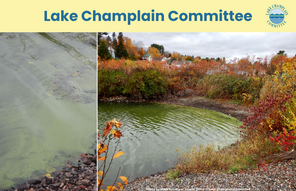
Just a reminder that the 2025 monitoring season officially wraps up on November 8th! As the season comes to a close, we want to thank you again for your dedication, careful observations, and timely reporting. This week, blooms were reported in three inland Vermont lakes and across three regions of Lake Champlain. Even as temperatures cool and morning frost covers the grass, cyanobacteria continue to make their presence known.
LCC Week 20 2025 Cyano. Monitoring Report
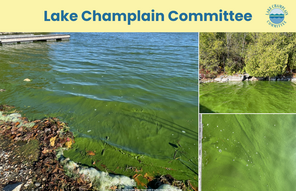
We’ve reached the final week of the 2025 cyanobacteria monitoring season. How the summer flew by! Our last monitor email will go out next week with a season wrap-up and highlights. This past week, most Lake Champlain sites showed low alert conditions, but a few inland Vermont lakes continued to post high alerts. Even as the weather cools, cyanobacteria are still hanging on in a few places.
LCC Week 21 2025 Cyano Monitoring Report
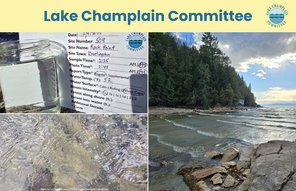
As the 2025 cyanobacteria monitoring season comes to an end, we want to extend our heartfelt thanks for your time, care, and commitment throughout the year. The season wrapped up quietly on Lake Champlain, with mostly clear reports with a couple low alerts. There were a few lingering blooms in three inland Vermont lakes. Even in the chill of early November, cyanobacteria made a few last appearances before the long winter pause. We’re grateful for all your efforts and hope you’ll join us again next year for another season of stewardship, observation, and connection to the lake we all care about.
